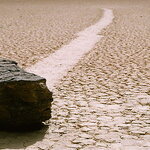Geology

Ice loss in Greenland, which has been increasing during the past decade over its southern region, is now moving up its northwest coast, according to a study published in Geophysical Research Letters.
A comparison of data from NASA's GRACE Satellite and continuous GPS measurements made from long-term sites on bedrock on the edges of the ice sheet revealed the ice loss. The study indicates the ice-loss acceleration began moving up the northwest coast of Greenland starting in late 2005.
The GPS and GRACE data provided the researchers with monthly averages of crustal uplift caused by ice-mass…

Rock Scissors Paper Custard
Ok, forget the scissors and paper - this article is about rocks
and custard.
The Sliding Rocks Of Racetrack Playa
Racetrack Playa is a dry lake bed in Death Valley National Park. It is famous for its sliding rocks. Theories that the rocks have been moved by people or animals have been ruled out. These rocks move according to some as yet unknown natural mechanism.
Image source: Wikimedia, Tahoenathan, GNU.
The sliding rocks are few in number and are found mainly in the southeast.
Examination of trail patterns shows an inferred general trend in…
Scientists at the University of California, San Diego are undertaking an expedition to explore the rupture site of the 8.8-magnitude Chilean earthquake.
The team hopes to capitalize on a unique opportunity to capture fresh data from the event by studying changes in the seafloor that resulted from movements along faults and submarine landslides.
The "rapid response" expedition, called the Survey of Earthquake And Rupture Offshore Chile, will take place aboard the research vessel Melville.
Scientists will map the rupture site of the 8.8-magnitude earthquake in Chile.
Credit: Jared Kluesner,…

NASA IceBridge Mission Prepares for Study of Arctic Glaciers
In a world where the blogosphere is filled with politically motivated versions of what is 'really' happening to the cryosphere it is good to know that real scientists are taking real risks to get real data. I take my hat off to them.
NASA IceBridge Mission Prepares for Study of Arctic Glaciers
Press release March 18, 2010
WASHINGTON -- NASA's Operation IceBridge mission, the largest airborne survey ever flown of Earth's polar ice, kicks off its second year of study when NASA aircraft arrive in Greenland March 22.
The IceBridge…

A Critique Of A Multiply-Published Article On Ice Sheet Collapse
An article in AIG News, the Australian Institute of Geoscientists Quarterly Newsletter No. 97 August 2009, purports to state that collapse of the Greenland and Antarctic ice sheets is impossible.
In this critique I demonstrate the writers' use of straw man arguments and other unscientific methods to support their arguments.
I commence with the authors' abstract and conclusions. The body of the text will be dealt with in due course.
Why the Greenland and Antarctic Ice Sheets are Not Collapsing.Cliff Ollier and Colin Pain…

The high-magnitude earthquake that struck southern Central Chile last month closed one of the two remaining seismic gaps at the South American plate boundary. After the quake in Concepción, the remaining gap in the north of Chile now holds potential for a comparable strong quake and is, thus, moving more and more into the focus of attention.
The GFZ German Research Centre for Geosciences has been monitoring this gap with the Integrated Plate Boundary Observatory (IPOC) in Chile since 2006, and now the duties will be taken up the Universidad de Chile and the Universidad Catolica del Norte.
"…

The Earth’s System
2010-02-21
Park Jae-Won
Over 2000 years ago, humans thought ‘What is our world created of?’ The answer was the atmosphere, hydrosphere, and the lithosphere. Well soon in the 20th century human added one more thing; organisms. Scientist found out that not only the atmosphere, hydrosphere, and the lithosphere is the thing that is making up the Earth, also we ‘organisms’ are making up the Earth.
1. Atmosphere
First, let’s take a look at the atmosphere. The atmosphere is what organism breath in the combine with glucose, and to make energy…
Preliminary measurements indicate that the massive magnitude 8.8 earthquake that struck the west coast of Chile in February moved the entire city of Concepcion at least 10 feet to the west, and shifted other parts of South America as far apart as the Falkland Islands and Fortaleza, Brazil.
Geophysicists say the data paint a much clearer picture of the power behind the massive earthquake, believed to be the fifth-most-powerful since instruments have been available to measure seismic shifts.
Buenos Aires, the capital of Argentina and across the continent from the quake's epicenter, moved about…

Continuing my earlier geomagnetism blurt:
University of Rochester geophysicist John Tarduno and an international team measured the magnetization of nanometer-sized magnetic inclusions, isolated within millimeter-sized quartz crystal inclusions, within 3.5 billion year old South African igneous rocks called dacites using a new, super-sensitive superconducting quantum interface device, or SQUID magnetometer.
According to their measurements and calculations, Earth's magnetic field 3.5 billion years ago was only half as strong as it is today, and the magnetopause was only half the…
Key To The Past, Key To The Future
This article is a brief overview and history of geochronology.
There are many things in nature that tend to grow in layers. Over the course of over 1,000 years, studies of layered objects have combined to show us that nature's laws of layering can be applied in a cross-disciplinary manner.
Whether we examine deposition layering in ice cores, tree rings, sediments or other features - by comparing past layers to present-day layers we find a cross-disciplinary key to layering mechanisms. Where clear mechanisms and trends can be discerned, deposition…